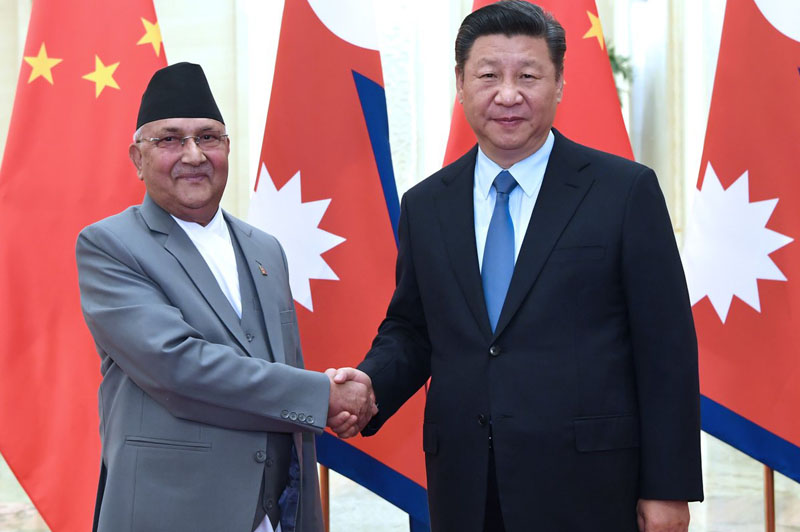Nepal's Dangerous Commitment to the One China Policy: A Threat to Sovereignty

Nepal’s Prime Minister K.P. Sharma Oli has, once again, reaffirmed the country’s unwavering support for China’s "One China" policy. On October 20, 2024, Oli declared that no anti-China activities would be allowed on Nepalese soil, a gesture meant to placate the powerful northern neighbor. While the government presents this as a diplomatic necessity, Nepal's history with China paints a far more troubling picture, one that raises important questions about the wisdom of such a commitment. The deep historical tensions, border disputes, and China’s continued pressure on Nepal through various forms of diplomacy indicate that Nepal’s sovereignty might be at risk under this policy.
Understanding the One China Policy
The One China Policy, a cornerstone of China’s foreign relations, mandates that countries recognize the People's Republic of China (PRC) as the sole legitimate government of China, which includes Taiwan and Tibet as integral parts of the country. This policy is non-negotiable for Beijing, and any nation wishing to maintain diplomatic relations with China must adhere to it. The policy stems from China’s desire to prevent international recognition of Taiwan as an independent state and to legitimize its hold on Tibet, a region it annexed in 1951. Countries like Nepal, which shares a long and complex history with both China and Tibet, have found themselves entangled in this policy due to their economic dependence on Beijing and geopolitical vulnerabilities.
A Historical Look at Nepal-China Relations
Nepal’s relationship with China has been fraught with tension for centuries, long before modern political dynamics took hold. One of the earliest and most notable confrontations was the Sino-Nepalese War of 1788-1792, a conflict that arose over trade disputes and territorial claims. The war ended in a peace treaty, but it established a pattern of unequal relations that continues to haunt Nepal to this day.
In 1960, Nepal and China signed a historic boundary treaty, marking the first official delineation of their shared border after China’s annexation of Tibet. However, the agreement was not without controversy. The treaty was seen by many as a surrender to Chinese interests, particularly in the Kalapani region, where territorial disputes continue to this day. Despite these agreements, China has consistently encroached upon Nepalese territory through a strategy known as "salami slicing," a gradual and often unnoticed form of territorial expansion. The most notable example occurred in the Humla district in 2020, when reports surfaced that Chinese soldiers had constructed buildings on Nepalese land, sparking public outrage. However, the government downplayed the incident, fearing repercussions from Beijing.
Perhaps even more troubling is the historical memory of Chinese military forces entering Nepalese territory and killing Nepalese soldiers. This occurred during the Sino-Nepalese War in the late 18th century when China’s Qing Dynasty retaliated against Nepal for its expansionist ambitions in Tibet. The brutality of that conflict, coupled with China’s overwhelming military superiority, set the tone for future relations, with Nepal often finding itself in a subservient position to its northern neighbor.
Tibet: A Shared History Lost to Annexation
Tibet, once a sovereign nation, maintained a close relationship with Nepal. The two regions shared not just a border, but also strong cultural, religious, and trade ties. Nepal played a significant role in Tibetan trade and politics, acting as a vital intermediary between Tibet and the outside world. However, this relationship was forever altered when China invaded Tibet in 1950 and formally annexed it in 1951. The annexation of Tibet by communist China marked a turning point in Nepal’s geopolitical landscape. For centuries, Nepal and Tibet had engaged in a lucrative trade relationship, particularly through salt, wool, and other goods that moved across the Himalayas. But after China took control of Tibet, that trade route was effectively cut off, and Nepal lost not only a valuable trading partner but also a culturally and religiously aligned neighbor.
The annexation of Tibet also led to the displacement of thousands of Tibetan refugees, many of whom sought sanctuary in Nepal. This influx of refugees has been a constant source of tension between Nepal and China, as Beijing pressures Kathmandu to restrict the activities of the Tibetan diaspora. In 2008, during the Beijing Olympics, Nepalese authorities, under heavy pressure from China, violently cracked down on Tibetan protesters in Kathmandu. This incident demonstrated the extent to which China can influence Nepal’s domestic policies, particularly when it comes to issues related to Tibet.
Border Encroachment and Neo-Imperialism
In recent years, China has adopted a more aggressive posture toward its smaller neighbors through what has been dubbed "wolf warrior diplomacy." This approach is characterized by assertive, often confrontational, tactics aimed at expanding Chinese influence and protecting its interests abroad. For Nepal, this has manifested in various ways, including ongoing border encroachments and diplomatic pressure to align more closely with Beijing’s policies.
One clear example of Chinese encroachment is the salami slicing strategy employed along the Nepal-China border. In this approach, small, incremental advancements are made into a neighboring country’s territory, often going unnoticed or unchallenged until significant areas have been claimed. This has been particularly evident in the northern districts of Nepal, where local residents have reported Chinese troops and workers building infrastructure on Nepalese land. Despite mounting evidence, the Nepalese government has been reluctant to confront Beijing, likely due to the economic and political repercussions that could follow.
Additionally, China’s Belt and Road Initiative (BRI) has been both a blessing and a curse for Nepal. While the infrastructure investments promised under the BRI could significantly boost Nepal’s economy, there is growing concern that these projects may lead to a debt trap, where Nepal becomes overly dependent on Chinese loans and, as a result, loses its economic sovereignty. Sri Lanka’s experience with the Hambantota port, which was leased to China for 99 years after the Sri Lankan government failed to repay its debts, serves as a cautionary tale for Nepal.
Threats to Nepal’s Sovereignty
Nepal’s leaders, particularly Prime Minister Oli, have repeatedly pledged their commitment to the One China Policy, framing it as a necessary stance for maintaining good relations with Beijing. However, this commitment raises serious concerns about Nepal’s sovereignty. By aligning so closely with China’s interests, Nepal risks becoming a vassal state, beholden to the whims of its powerful northern neighbor.
One of the most significant threats posed by China is its ability to dictate Nepal’s foreign and domestic policies. For example, China has been known to exert considerable pressure on Nepal to suppress any activities related to Tibetan independence, including protests, cultural events, and even religious ceremonies. This has led to a chilling effect on free speech and assembly in Nepal, as authorities crack down on anything that might offend Beijing.
Moreover, China’s influence extends beyond the political sphere and into Nepal’s economic and infrastructure sectors. The Belt and Road Initiative, while offering the potential for economic development, also comes with significant strings attached. Nepal’s growing reliance on Chinese investment and loans could eventually lead to a situation where Beijing exerts even greater control over Nepal’s internal affairs.
Conclusion: The Illogical Support for One China Policy
The continued support for the One China Policy by Nepal’s leadership, particularly Prime Minister Oli, is not just a diplomatic stance; it is a sign of Nepal’s growing subservience to China. Historically, Nepal has faced numerous challenges from its northern neighbor, from border disputes to military incursions. The annexation of Tibet and the loss of a culturally aligned trading partner further strained relations, and in recent years, China’s aggressive tactics, such as border encroachment and debt diplomacy, have only heightened concerns about Nepal’s sovereignty.
It is illogical for Nepal to continue supporting the One China Policy when it is clear that China poses a significant threat to Nepal’s territorial integrity and political independence. Instead of bowing to Chinese pressure, Nepal’s leaders should prioritize the country’s sovereignty and seek to establish a more balanced relationship with both China and other global powers. Only by asserting its independence and standing up to Chinese aggression can Nepal protect its sovereignty and secure a brighter future for its people.

![From Kathmandu to the World: How Excel Students Are Winning Big [Admission Open]](https://nepalaaja.com/img/70194/medium/excel-college-info-eng-nep-2342.jpg)


